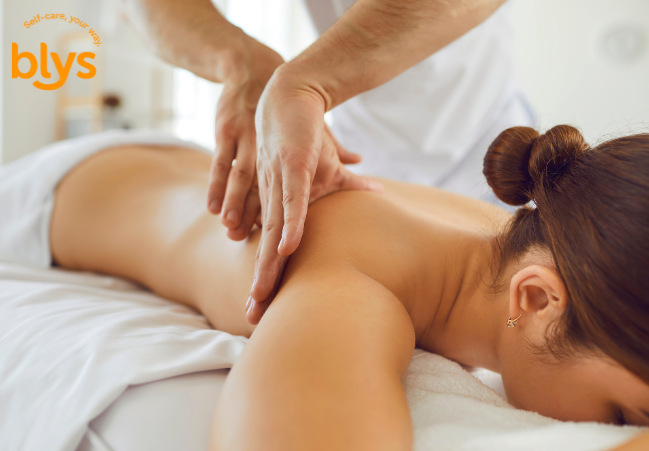
In today’s fast-paced digital world, poor posture has become more than just a bad habit it’s a widespread issue affecting thousands of Brits. From sitting at desks for eight hours a day to commuting long hours and scrolling on phones during downtime, our modern lifestyles often work against proper alignment. The result? Rounded shoulders, tight necks, stiff hips, and nagging back pain that can interfere with everyday comfort and productivity.
What’s more, poor posture tends to build up quietly. You may not notice the gradual tension or muscular imbalance until it leads to chronic discomfort or even injury. Office workers, in particular, are prone to these issues due to limited movement, poor desk ergonomics, and high mental demands.
That’s why more people are now turning to evidence-based solutions like remedial massage to actively correct postural issues and restore muscular balance. This isn’t just about relaxation it’s targeted therapy that works.
With Blys, you don’t need to travel or adjust your packed schedule. Our mobile remedial massage service connects you with qualified therapists who bring care directly to your home, office, or hotel when and where it suits you.
Understanding Postural Imbalances
A postural imbalance arises when your body’s natural alignment where the head, spine, and hips form a straight vertical line is disrupted. This often happens due to muscle tightness or weakness and prolonged poor positioning. Over time, misaligned posture forces muscles and joints to work unevenly, increasing the risk of discomfort, reduced mobility, or injury.
What causes these imbalances?
- Prolonged sitting: Staying seated for hours in one position encourages slouching or forward head posture.
- Tech neck: Constantly looking down at phones or leaning in to view screens strains the neck and upper back.
- Poor workstation setup: Screens too low, chairs without proper lumbar support, or desks at the wrong height all contribute.
- Repetitive movements: Activities like typing, mouse use, or manual lifting without proper form can create muscle imbalances.
Spotting the signs:
- Rounded shoulders and a hunched upper back
- Neck tightness or recurring tension headaches
- Lower back pain or stiff hips
- Stiffness or limited range of movement
Research shows that desk-based workers spend over 95% of their time sitting, significantly increasing the likelihood of neck–shoulder pain after just three years. Globally, office workers report neck pain rates between 15% and 43% annually, significantly higher than the general population. And a major recent meta-analysis confirmed that six hours of sedentary screen time daily notably increases neck pain risk, especially among office employees.
Recognising these early signs allows for targeted support and that’s where remedial massage becomes a key ally in rebalancing posture and alleviating discomfort.
If you’re also managing ongoing discomfort, read more about how remedial massage helps with chronic pain and how it fits into long-term pain management.
How Remedial Massage Helps with Posture Correction
Poor posture isn’t just a visual concern it affects how your muscles function, how you breathe, and even how fatigued you feel by the end of the day. Over time, imbalances from sitting too long, hunching over screens, or repetitive daily habits can overload certain muscles while weakening others. Remedial massage addresses these patterns by targeting both the cause and the symptoms.
The process begins with a thorough assessment. Your therapist evaluates your posture, range of motion, and areas of tension not just identifying where it hurts, but understanding what’s contributing to the imbalance. This sets the stage for a tailored treatment plan that restores alignment and function.
A combination of hands-on techniques is used to release tension and reactivate underused muscles. Here’s how each method works and where it’s most commonly applied:
| Technique | Purpose | Commonly Targeted Areas |
| Deep tissue massage | Releases chronic muscular tension | Trapezius, rhomboids, lower back |
| Myofascial release | Eases tight connective tissues and improves mobility | Pectoralis major/minor, thoracic spine |
| Trigger point therapy | Deactivates muscle knots that restrict movement or cause referred pain | Levator scapulae, neck, hip flexors |
These techniques help correct common postural problems caused by prolonged sitting, desk work, or frequent phone and computer use. Muscles such as the upper back, chest, and hips often become tight and shortened, pulling the body out of alignment and increasing the risk of pain or injury.
With regular remedial massage, you can experience a wide range of long-term benefits:
- Increased flexibility: in tight muscles, making better posture easier to maintain
- Improved circulation: which helps flush out waste products and reduce inflammation
- Balanced muscle function: so that no area is overcompensating for weakness elsewhere
- Encouraged postural awareness: helping your body reset into healthier alignment
- Reduced tension and pain: especially in the neck, shoulders, lower back, and hips
According to a 2020 review, massage therapy shows moderate to strong evidence in reducing chronic musculoskeletal pain when combined with proper aftercare and self-management strategies.
Why Remedial Massage Is Ideal for Office Workers
While office jobs might appear low-impact, the physical strain of sitting for hours, day after day, often goes unnoticed until pain sets in. Here’s why remedial massage is one of the best tools to help office workers stay pain-free, productive, and energised.
1. Directly Targets Desk-Related Tension
Office workers frequently suffer from tight upper traps, stiff necks, lower back pain, and tight hip flexors due to repetitive tasks and static postures. Remedial massage is tailored to address these common muscular imbalances, focusing on the exact areas under stress. It’s not a general relaxation massage—it’s treatment with purpose.
2. Interrupts the Build-up of Chronic Strain
Postural issues don’t appear overnight. They build gradually from micro-strains that go unchecked. Remedial massage helps release tension before it becomes chronic, improving muscle function and joint mobility, and reducing the risk of more serious conditions like nerve impingement or tension headaches.
3. Works Around Your Schedule
Time is a luxury for most professionals. With Blys’ mobile massage service, there’s no need to travel or take time off work. Book a session at your home, office, or hotel—whether it’s during a lunch break or after hours. This flexibility makes it easy to stay consistent with your care.
4. Improves Focus, Mood, and Productivity
Beyond posture correction, massage supports mental wellbeing. By reducing muscle tightness and activating the parasympathetic nervous system, it helps lower stress levels, improve sleep, and boost concentration factors that directly affect performance at work.
5. Supports Long-Term Musculoskeletal Health
Preventing issues is more effective than treating them after they escalate. Regular remedial massage works as a preventative strategy, maintaining muscle balance and function, and helping you feel stronger and more aligned over time.
When integrated into your regular routine, remedial massage becomes more than just relief it becomes a tool for resilience. And with Blys, making self-care part of your week is no longer a hassle it’s as easy as booking online and relaxing where you are.
Posture-Friendly Habits to Support Your Massage Results
Remedial massage provides significant relief from postural strain, but keeping those results long-term depends on how you support your body in between sessions. These posture-friendly habits work alongside massage to maintain muscular balance, reduce daily tension, and improve how your body holds itself through each task.
Stretch and Move Daily
Office-related posture issues often stem from shortened chest muscles and stiff thoracic spines. Incorporating mobility work into your day can help release tension and restore natural movement.
- Do a doorway chest stretch by placing your forearms on a doorframe and gently leaning forward to open up your chest.
- Add thoracic spine extensions, such as lying over a rolled towel or performing prone “Y” reaches to improve upper-back mobility.
Set Up Your Desk for Better Ergonomics
A poorly arranged workstation will undo the benefits of massage by pulling your body back into unhealthy patterns. A few ergonomic tweaks go a long way.
- Ensure your monitor is at eye level to reduce neck strain and avoid a forward head posture.
- Use a chair with proper lumbar support, or add a cushion to maintain your lower back’s natural curve.
Take Regular Movement Breaks
Even with good posture, sitting in one position too long leads to stiffness. Movement keeps joints mobile and muscles engaged.
- Stand up every 30–60 minutes, even if just for a quick walk or stretch.
- Include shoulder rolls and gentle neck movements while seated to prevent tension buildup.
Support Your Body During Sleep
our sleeping posture is just as important as how you sit or stand during the day. A well-supported neck and spine overnight can reduce morning stiffness and complement your massage results.
- If you sleep on your back, use a cervical pillow or neck roll to maintain alignment.
- For side sleepers, choose a pillow that keeps your head level with your spine, and place another between your knees to relieve lower back pressure.
These small but consistent habits don’t require a complete lifestyle overhaul—just intention and awareness. By combining daily movement, proper workstation setup, and supportive sleep habits with regular remedial massage, you create a strong foundation for lasting posture improvement. Over time, your body will feel stronger, more mobile, and less prone to those nagging aches that once seemed unavoidable.
Want to learn more about stubborn muscle knots? Explore how trigger points are treated through remedial massage and why they matter for posture and pain relief.
What to Expect During Your Blys Remedial Massage
If you’re new to remedial massage or just haven’t experienced it through Blys it helps to know what sets this service apart. Beyond relaxation, remedial massage is structured, evidence-based therapy that’s tailored to your body’s specific needs. And with Blys, it all happens in your space, on your schedule.
1. Therapist arrival and setup
Your Blys therapist arrives at your home, office, or hotel fully prepared. They bring along a professional massage table, clean linens, massage oils, and any equipment required for the session. All you need to do is clear a space ideally somewhere quiet and comfortable, with enough room for the therapist to work safely around the table. No travel, no waiting room, no stress.
2. Initial consultation
Before the massage begins, your therapist will conduct a short consultation to understand your concerns and goals. This may include questions about your posture habits, daily movement patterns, work environment, recent injuries, and areas of tension.
This step ensures that the treatment is personalised whether you’re dealing with stiffness from long hours at a desk, poor ergonomic setup, or chronic muscle fatigue.
3. Tailored, hands-on treatment
Once the consultation is complete, the therapist begins working on the muscles that are contributing to your posture issues. These typically include the traps, levator scapulae, pectoral muscles, hip flexors, and lower back. Depending on what your body needs, the therapist may apply a combination of deep tissue massage, myofascial release, and trigger point therapy.
These techniques are designed to reduce tension, improve mobility, and bring your body back toward balanced alignment. The pressure is adjusted throughout the session based on your comfort and feedback.
4. Post-session aftercare and advice
After the massage, your therapist will give you specific recommendations to support recovery and prolong the benefits of the session. This may include hydration advice, tips for gentle movement or stretching, the use of heat or ice, and ergonomic changes you can make to avoid recurring tension. If needed, your therapist might suggest follow-up sessions to continue progress and prevent chronic discomfort from returning.
With Blys, the experience is designed around your lifestyle delivering expert, therapeutic care in a way that’s flexible, comfortable, and incredibly effective
Whether it’s your first session or part of your long-term wellness routine, you can expect treatment that not only addresses your symptoms but also supports your posture in the long run.
When You Should Avoid or Modify Massage
While remedial massage is highly effective for posture correction and muscular tension, there are times when it’s best to delay or adjust treatment for your safety.
If you’ve recently suffered a muscle strain, sprain, or other injury, massage should be avoided during the first 48 to 72 hours. Signs like swelling, heat, or sharp pain often indicate acute inflammation, which needs rest and recovery not pressure.
Massage should also be avoided after surgery unless you have clearance from your doctor. Even if you feel ready, your body may still be healing internally. Pushing too soon can disrupt the recovery process and lead to complications.
If you’re unwell with a fever, flu, or infection or have open wounds or skin irritation—it’s best to wait until symptoms clear completely. Massage increases circulation, which can spread infection or worsen inflammation.
In some cases, you may need to speak with your GP before booking a session, especially if you’re pregnant, taking certain medications, or living with a chronic condition. A quick check-in can help confirm whether massage is right for you or if modifications are needed.
Blys therapists are trained to screen for these situations and will always prioritise your wellbeing. Being upfront about your condition ensures your session is both safe and effective.
Restore Balance, Comfort, and Confidence With Blys
Posture plays a major role in how we feel, move, and perform especially for office workers who spend long hours at a desk. When posture is compromised, it can lead to daily discomfort, reduced mobility, and even long-term pain. Over time, it doesn’t just affect your physical health it can impact your energy levels, focus, and overall wellbeing.
Remedial massage offers a proactive way to correct these imbalances before they become bigger issues. By targeting the muscles responsible for poor posture and helping the body return to proper alignment, it provides both relief and long-term support. Unlike generic treatments, remedial massage is tailored to your body’s specific needs making it a powerful addition to any wellness routine.
If you’ve been feeling the strain from long hours in front of a screen, now’s the time to act. With Blys, expert remedial massage comes to you so it fits into your day without adding stress to your schedule.
Struggling with posture pain from desk work? Try remedial massage for office workers on your schedule, in your space.
Book now with Blys and take the first step toward feeling better, moving freely, and standing taller.





